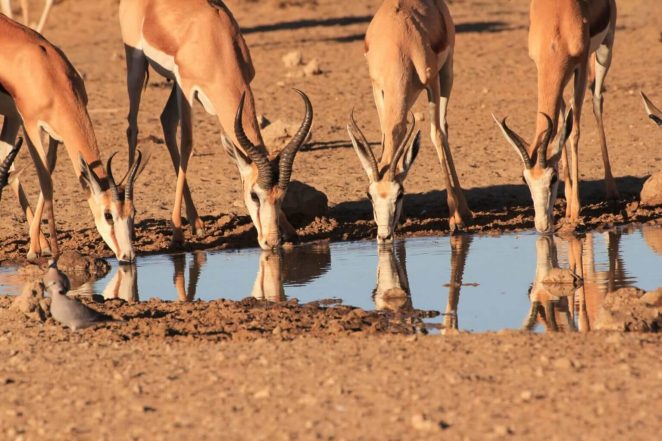Mammals of Africa’s Desert Areas – Springbok
Habitat, Description, Social Structure, Behavior of Desert Herbivore
Springbok numbering thousands were a common sight in the African deserts. These numbers have dwindled to herds consisting of hundreds and are confined to Wildlife Reserves including the Kgalagadi Transfrontier Park and Mabuasehube Game Reserve and farms.
Habitat of Springbok
Springbok inhabit the Central, Western and Northern Cape Province of South Africa, Namibia, except the Caprivi belt and the most northern region, and Central and South Western Botswana. These herbivores prefer the dry open shrub land, grassland and dry riverbeds.
Physical Description of Springbok
Light brown and white dominate the coat of the Springbok. The back and sides are light brown while the stomach, legs, tail and face are white. A brown stripe runs down every leg and on top of the tail. Two black grooves connect the nose and the inner side of the eye. A band of longer white hair runs from the neck to the middle of the back which is raised during ‘pronking’ (a stiff legged jump where the back is arched, the head lowered and the legs brought closer together) or when they are frightened.
There are no visible differences between the sexes although ewes are slightly lighter than rams. The Adult rams weigh between thirty-three and forty-eight kilograms and adult ewes between thirty and forty-four kilograms. The average shoulder height according to Robin Frandsen, Southern African Mammals – A Field Guide, Honeyguide Publications, 1998, is seventy-five centimeters. Both rams and ewes have horns which measure thirty-five centimeters on average, but a length of forty-nine centimeters long have been recorded. The horns bend backwards and in adult Springbok turn inwards at the ends.

Social Structure of Springbok
Springbok form small herds, but when migrating to greener pastures in Spring, larger herds are formed. The composition of the herds vary from mixed to only rams to territorial rams. They are territorial animals to the extent that a ram might attempt to keep the herd of ewes within his territory, but will not force them to stay if the ewes want to leave. Lone rams, often seen in dry riverbeds, mate with the herds of females moving through their area and defend the territory against any other intruding rams. Herds move slowly through an area and form a loose association with other herbivores like Gemsbok, Hartebeest, Wildebeest and sometimes even ostriches.
Behavior and Adaptations to Desert Conditions
Springbok graze during the day, usually early morning and late afternoon, and eat grass, shrubs and fruit. They do not need water as long as the water content of the plants consumed is above ten percent.
The Oribi also practice pronking, but the Springbok is the master of the art. When threatened or running away from danger, it jump into the air with stiff legs, arches its back and raise the hair on the back and neck.
As Springbok breed through the year, a ewe can come into season soon after giving birth. During February and March food is abundant in the Kalahari and most lambs are born in this time. A single lamb, seldom two, is born after a gestation period of approximately six months. The youngsters group together in crèches adding protection against predators like Lion, Hyena, Leopard, Cheetah, Wild dogs and Jackals.
Springbok are not only icons of Africa’s desert areas, but also the national emblem of the South African Rugby team.


